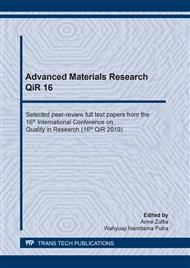[1]
O'Regan, B.; Grätzel, M., A low-cost, high-efficiency solar cell based on dye-sensitized colloidal TiO2 films. Nature 1991, 353, (6346), 737-740.
DOI: 10.1038/353737a0
Google Scholar
[2]
Wang, Z. L., Zinc oxide nanostructures: growth, properties and applications. Journal of Physics: Condensed Matter 2004, 16, (25), R829-R858.
DOI: 10.1088/0953-8984/16/25/r01
Google Scholar
[3]
Chandiran, A. K.; Abdi-Jalebi, M.; Nazeeruddin, M. K.; Grätzel, M., Analysis of Electron Transfer Properties of ZnO and TiO2 Photoanodes for Dye-Sensitized Solar Cells. ACS Nano 2014, 8, (3), 2261-2268.
DOI: 10.1021/nn405535j
Google Scholar
[4]
Zhang, Q.; Dandeneau, C. S.; Zhou, X.; Cao, G., ZnO Nanostructures for Dye-Sensitized Solar Cells. Advanced Materials 2009, 21, (41), 4087-4108.
DOI: 10.1002/adma.200803827
Google Scholar
[5]
Lee, K. S.; Lee, H. K.; Wang, D. H.; Park, N.-G.; Lee, J. Y.; Park, O. O.; Park, J. H., Dye-sensitized solar cells with Pt- and TCO-free counter electrodes. Chemical Communications 2010, 46, (25), 4505-4507.
DOI: 10.1039/c0cc00432d
Google Scholar
[6]
Smestad, G.; Bignozzi, C.; Argazzi, R., Testing of dye sensitized TiO2 solar cells I: Experimental photocurrent output and conversion efficiencies. Solar Energy Materials and Solar Cells 1994, 32, (3), 259-272.
DOI: 10.1016/0927-0248(94)90263-1
Google Scholar
[7]
Ramasamy, E.; Lee, J., Large-pore sized mesoporous carbon electrocatalyst for efficient dye-sensitized solar cells. Chemical Communications 2010, 46, (12), 2136-2138.
DOI: 10.1039/b920916f
Google Scholar
[8]
Kay, A.; Grätzel, M., Low cost photovoltaic modules based on dye sensitized nanocrystalline titanium dioxide and carbon powder. Solar Energy Materials and Solar Cells 1996, 44, (1), 99-117.
DOI: 10.1016/0927-0248(96)00063-3
Google Scholar
[9]
Cha, S. I.; Koo, B. K.; Seo, S. H.; Lee, D. Y., Pt-free transparent counter electrodes for dye-sensitized solar cells prepared from carbon nanotube micro-balls. Journal of Materials Chemistry 2010, 20, (4), 659-662.
DOI: 10.1039/b918920c
Google Scholar
[10]
Suzuki, K.; Yamaguchi, M.; Kumagai, M.; Yanagida, S., Application of Carbon Nanotubes to Counter Electrodes of Dye-sensitized Solar Cells. Chemistry Letters 2002, 32, (1), 28-29.
DOI: 10.1246/cl.2003.28
Google Scholar
[11]
Imoto, K.; Takahashi, K.; Yamaguchi, T.; Komura, T.; Nakamura, J.-i.; Murata, K., High-performance carbon counter electrode for dye-sensitized solar cells. Solar Energy Materials and Solar Cells 2003, 79, (4), 459-469.
DOI: 10.1016/s0927-0248(03)00021-7
Google Scholar
[12]
Murakami, T. N.; Ito, S.; Wang, Q.; Nazeeruddin, M. K.; Bessho, T.; Cesar, I.; Liska, P.; Humphry-Baker, R.; Comte, P.; Péchy, P., Highly efficient dye-sensitized solar cells based on carbon black counter electrodes. Journal of the Electrochemical Society 2006, 153, (12), A2255-A2261.
DOI: 10.1149/1.2358087
Google Scholar
[13]
Yang, N.; Zhai, J.; Wang, D.; Chen, Y.; Jiang, L., Two-Dimensional Graphene Bridges Enhanced Photoinduced Charge Transport in Dye-Sensitized Solar Cells. ACS Nano 2010, 4, (2), 887-894.
DOI: 10.1021/nn901660v
Google Scholar
[14]
Choi, H.; Kim, H.; Hwang, S.; Choi, W.; Jeon, M., Dye-sensitized solar cells using graphene-based carbon nano composite as counter electrode. Solar Energy Materials and Solar Cells 2011, 95, (1), 323-325.
DOI: 10.1016/j.solmat.2010.04.044
Google Scholar
[15]
Selopal, G. S.; Milan, R.; Ortolani, L.; Morandi, V.; Rizzoli, R.; Sberveglieri, G.; Veronese, G. P.; Vomiero, A.; Concina, I., Graphene as transparent front contact for dye sensitized solar cells. Solar Energy Materials and Solar Cells 2015, 135, 99-105.
DOI: 10.1016/j.solmat.2014.10.016
Google Scholar
[16]
Novoselov, K. S.; Blake, P.; Katsnelson, M. I., Graphene: Electronic Properties. In Encyclopedia of Materials: Science and Technology, Buschow, K. H. J.; Cahn, R. W.; Flemings, M. C.; Ilschner, B.; Kramer, E. J.; Mahajan, S.; Veyssière, P., Eds. Elsevier: Oxford, 2008; pp.1-6.
DOI: 10.1016/b0-08-043152-6/01865-9
Google Scholar
[17]
Novoselov, K. S.; Geim, A. K.; Morozov, S. V.; Jiang, D.; Zhang, Y.; Dubonos, S. V.; Grigorieva, I. V.; Firsov, A. A., Electric Field Effect in Atomically Thin Carbon Films. Science 2004, 306, (5696), 666–669.
DOI: 10.1126/science.1102896
Google Scholar
[18]
Suhaimi, L.; Yuwono, A. H.; Hudaya, C., The influence of different seeds solution concentration upon chemical bath deposition process on the morphology of ZnO nanorods. Journal of Physics: Conference Series 2019, 1170, 012059.
DOI: 10.1088/1742-6596/1170/1/012059
Google Scholar
[19]
Yuwono, A. H.; Sholehah, A.; Harjanto, S.; Dhaneswara, D.; Maulidiah, F., Optimizing the Nanostructural Characteristics of Chemical Bath Deposition Derived ZnO Nanorods by Post-Hydrothermal Treatments. Advanced Materials Research, 2013, 789, 132-137.
DOI: 10.4028/www.scientific.net/amr.789.132
Google Scholar
[20]
Hummers, W. S.; Offeman, R. E., Preparation of Graphitic Oxide. Journal of the American Chemical Society 1958, 80, (6), 1339.
DOI: 10.1021/ja01539a017
Google Scholar
[21]
Madsuha, A. F.; Van Pham, C.; Eck, M.; Neukom, M.; Krueger, M., Improved Hole Injection in Bulk Heterojunction (BHJ) Hybrid Solar Cells by Applying a Thermally Reduced Graphene Oxide Buffer Layer. Journal of Nanomaterials 2019, 2019, 10.
DOI: 10.1155/2019/6095863
Google Scholar
[22]
Xu, K.; Shen, Y.; Zhang, Z.; Cao, M.; Gu, F.; Wang, L., The influence of different modified graphene on property of DSSCs. Applied Surface Science, 2016, 362, 477-482.
DOI: 10.1016/j.apsusc.2015.09.265
Google Scholar
[23]
Shojaeenezhad, S. S.; Farbod, M.; Kazeminezhad, I., Effects of initial graphite particle size and shape on oxidation time in graphene oxide prepared by Hummers' method. Journal of Science: Advanced Materials and Devices 2017, 2, (4), 470-475.
DOI: 10.1016/j.jsamd.2017.09.003
Google Scholar


